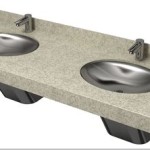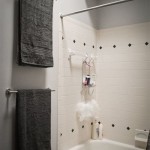How to Fix a Leaky Bathroom Vanity Faucet
A leaky bathroom vanity faucet is a common household problem that can lead to wasted water, increased water bills, and potential damage to the vanity cabinet and surrounding areas. Identifying the source of the leak and undertaking the necessary repairs can often be accomplished without professional assistance, saving both time and money. This article provides a comprehensive guide on how to diagnose and fix a leaky bathroom vanity faucet, covering various faucet types and common causes of leaks.
Before commencing any repairs, it is crucial to gather the necessary tools and materials. These typically include:
*Adjustable wrench
*Phillips head and flathead screwdrivers
*Penetrating oil
*Sink wrench (basin wrench)
*Pliers
*New O-rings, washers, and valve cartridges (as needed)
*Clean cloths or paper towels
*Small container to catch water
*Safety glasses
*Work gloves
Prior to working on the faucet, the water supply must be shut off. Locate the shut-off valves under the sink for both the hot and cold water lines. Turn these valves clockwise until they are completely closed. If the valves are corroded or difficult to turn, apply penetrating oil and allow it to sit for a few minutes before attempting to close them again. If the shut-off valves are not functioning correctly, the main water supply to the house may need to be turned off. Once the water supply is shut off, turn on the faucet to relieve any remaining pressure in the lines.
Identifying the Source of the Leak
The initial step in fixing a leaky faucet is to accurately identify where the leak is originating. Leaks can manifest in several areas, including the spout, the base of the faucet, under the sink, or around the handles. Observing the leak carefully can provide valuable clues about the underlying problem.
If the leak is emanating from the spout, especially a dripping sound even when the faucet is turned off, the likely cause is a worn-out valve cartridge or ceramic disc within the faucet. In two-handle faucets, each handle controls a separate valve, and only the leaking side needs attention. Single-handle faucets control both hot and cold water through a single cartridge, requiring replacement of the entire unit.
Leaks occurring at the base of the faucet are often due to deteriorated O-rings or seals that connect the faucet to the sink. These seals can become brittle and crack over time, allowing water to seep through. Similarly, leaks appearing under the sink, where the water supply lines connect to the faucet, usually indicate loose connections or damaged supply line connectors requiring tightening or replacement.
Leaks around the faucet handles suggest worn-out O-rings or packing nuts. Replacing these components can often resolve this type of leak. Determining the specific location of the leak significantly narrows down the potential causes and directs the repair efforts more effectively.
Repairing Different Types of Faucets
Bathroom vanity faucets come in various designs, each with its own unique internal mechanisms. The most common types include compression faucets, ball faucets, cartridge faucets, and ceramic disc faucets. Each type requires a different approach for repair.
Compression Faucets: These are the oldest and generally the simplest type of faucet. They are characterized by separate hot and cold water handles that, when turned, compress a rubber washer against a valve seat to stop the flow of water. Leaks in compression faucets are most often caused by worn-out washers. To repair a compression faucet, first, remove the handle by unscrewing the retaining screw, which is usually located under a decorative cap on the handle. Once the handle is removed, use an adjustable wrench to unscrew the valve stem. Examine the rubber washer at the end of the valve stem for wear or damage. Replace the washer with a new one of the same size and type. Inspect the valve seat for corrosion or damage. If the seat is damaged, it may need to be resurfaced using a valve seat grinding tool, or the entire faucet may need to be replaced. Before reassembling the faucet, apply a thin layer of plumber's grease to the threads of the valve stem to ensure smooth operation.
Ball Faucets: These single-handle faucets use a slotted ball to control the flow and temperature of water. Leaks in ball faucets are commonly caused by worn-out springs, seats, or O-rings within the faucet body. To repair a ball faucet, first, loosen the set screw on the side of the handle and remove the handle. Unscrew the cap and collar to expose the ball. Carefully lift out the ball and inspect it for any damage or wear. Using a small tool, remove the springs and seats located beneath the ball. Replace the springs and seats with new ones. Replace any O-rings on the spout and faucet body that appear worn or damaged. Reassemble the faucet in the reverse order, ensuring that all components are properly aligned.
Cartridge Faucets: These faucets utilize a cartridge to control the flow and temperature of water. Leaks in cartridge faucets are typically caused by a worn-out or damaged cartridge. To repair a cartridge faucet, first, remove the handle by unscrewing the retaining screw, which is often located under a decorative cap or on the side of the handle. Depending on the faucet design, there may be a retaining clip or nut that needs to be removed to release the cartridge. Once the retaining clip or nut is removed, carefully pull out the cartridge. It may be necessary to use pliers to gently wiggle the cartridge loose. Before installing the new cartridge, ensure that it is the correct type and size for the faucet. Insert the new cartridge into the faucet body, aligning it properly. Secure the cartridge with the retaining clip or nut. Reassemble the handle and tighten the retaining screw.
Ceramic Disc Faucets: These faucets are known for their durability and smooth operation. They use two ceramic discs to control the flow of water. Leaks in ceramic disc faucets are often caused by debris or mineral buildup between the discs or by damaged seals. To repair a ceramic disc faucet, first, remove the handle by unscrewing the retaining screw. Remove the escutcheon cap to expose the ceramic disc cylinder. Loosen the cylinder mounting screws and carefully lift out the cylinder. Inspect the ceramic discs for any cracks or damage. Clean the discs and cylinder with a mild cleaner to remove any debris or mineral buildup. Replace any worn or damaged seals. Reassemble the faucet in the reverse order, ensuring that the ceramic discs are properly aligned.
Replacing O-Rings and Washers
O-rings and washers are essential components of many bathroom vanity faucets, providing a watertight seal between various parts. Over time, these components can deteriorate due to constant exposure to water, temperature fluctuations, and mineral deposits. Replacing worn-out O-rings and washers is a common and often necessary step in fixing a leaky faucet.
To replace an O-ring, first, identify the O-ring that needs replacement. This may involve disassembling the faucet to access the O-ring. Once the O-ring is accessible, carefully remove it using a small pick or screwdriver, being careful not to damage the surrounding surfaces. Measure the old O-ring to ensure that the replacement O-ring is the correct size. Apply a thin layer of plumber's grease to the new O-ring before installing it. This will help to create a better seal and prolong the life of the O-ring.
To replace a washer, first, identify the washer that needs replacement. Washers are commonly found in compression faucets and under faucet handles. Remove the old washer using a screwdriver or pliers. Ensure that the replacement washer is the same size and type as the old washer. Install the new washer in the same location as the old washer. Tighten the surrounding hardware to ensure that the washer is properly seated and creates a watertight seal.
When replacing O-rings and washers, it is important to use high-quality replacement parts that are designed for use in plumbing applications. Using generic or low-quality parts may result in premature failure and the recurrence of leaks. Plumber's grease should always be used when installing O-rings and washers to provide lubrication and prevent damage to the rubber or plastic components.
After completing the repairs, turn the water supply back on slowly and check for any leaks. If leaks persist, double-check the connections and ensure that all components are properly tightened. If the leak persists despite these efforts, it may be necessary to consult a professional plumber.
Regular maintenance, such as cleaning the faucet and checking for leaks periodically, can help prevent future problems and prolong the life of the faucet.

How To Fix A Leaky Faucet The Home Depot

How To Fix A Dripping Moen Faucet Howtolou Com

Fix A Leaky Faucet Double Handle Diy

How To Fix A Leaky Faucet The Home Depot

How To Fix Leaky Bathroom Handle Delta Faucet Model 4530 Series Hard Water

How To Fix A Leaking Bathroom Faucet Quit That Drip

Old House Handyman Fixing Leaky Faucet Turns Into Family Affair
:strip_icc()/102381729-bf6543ca231b4edeafadca7eaab2ef1e.jpg?strip=all)
How To Fix A Bathroom Faucet That S Leaking

3 Ways To Fix A Leaky Faucet Common Causes Of Leaks

How To Fix A Bathroom Faucet That S Leaking
Related Posts







